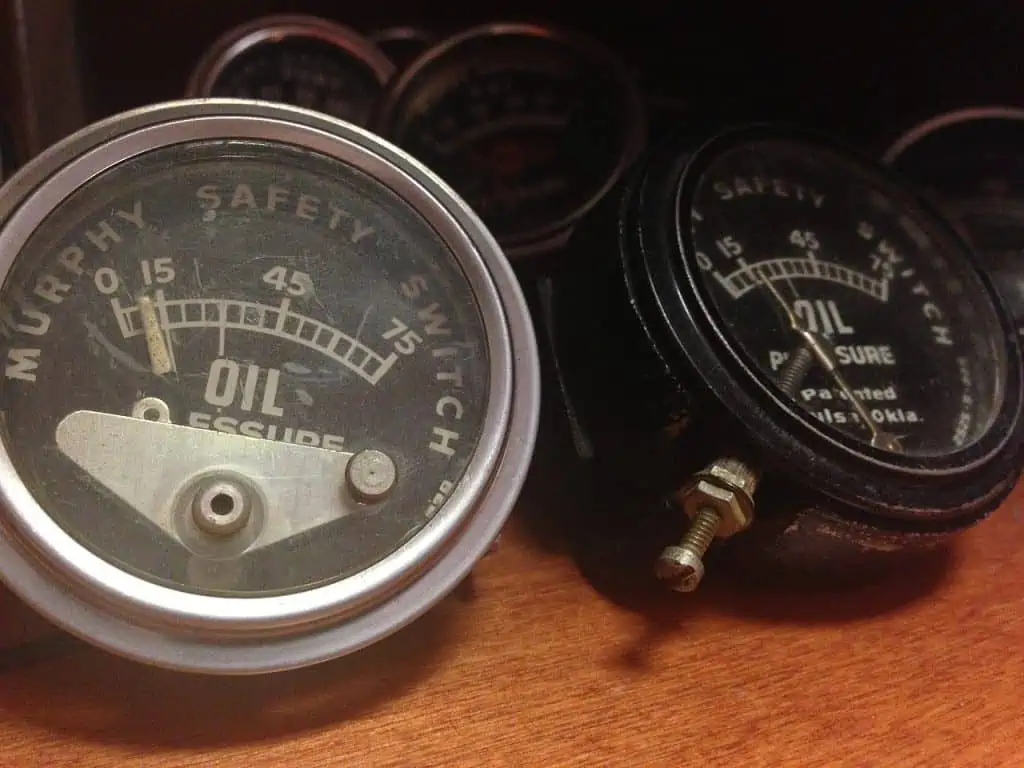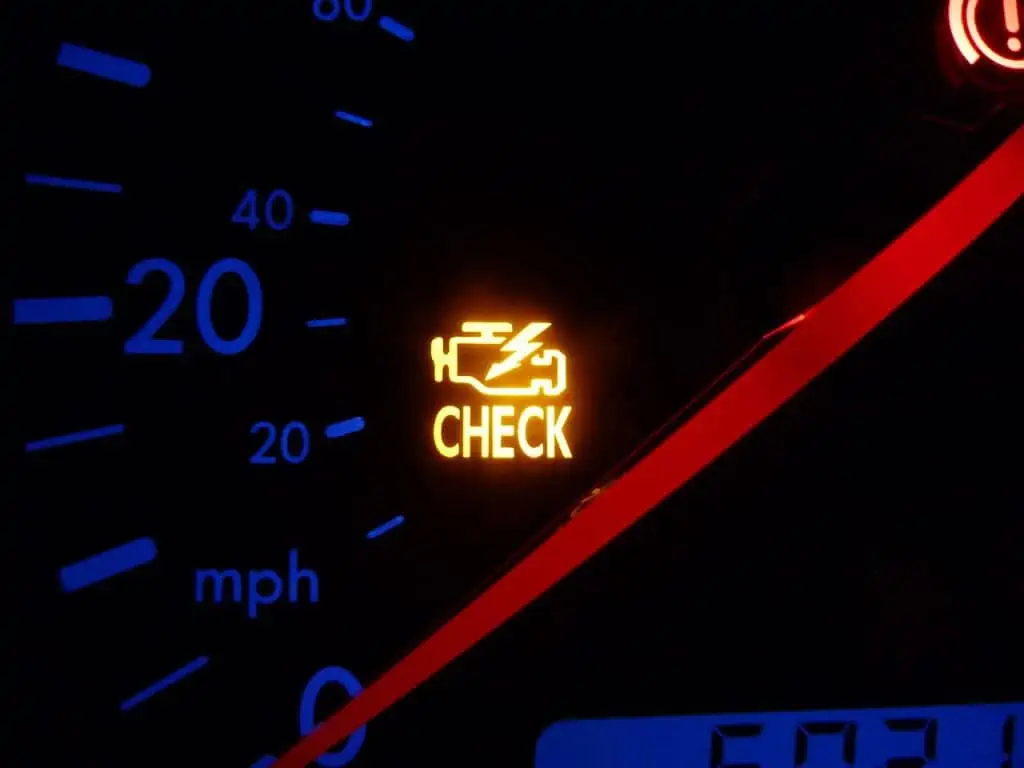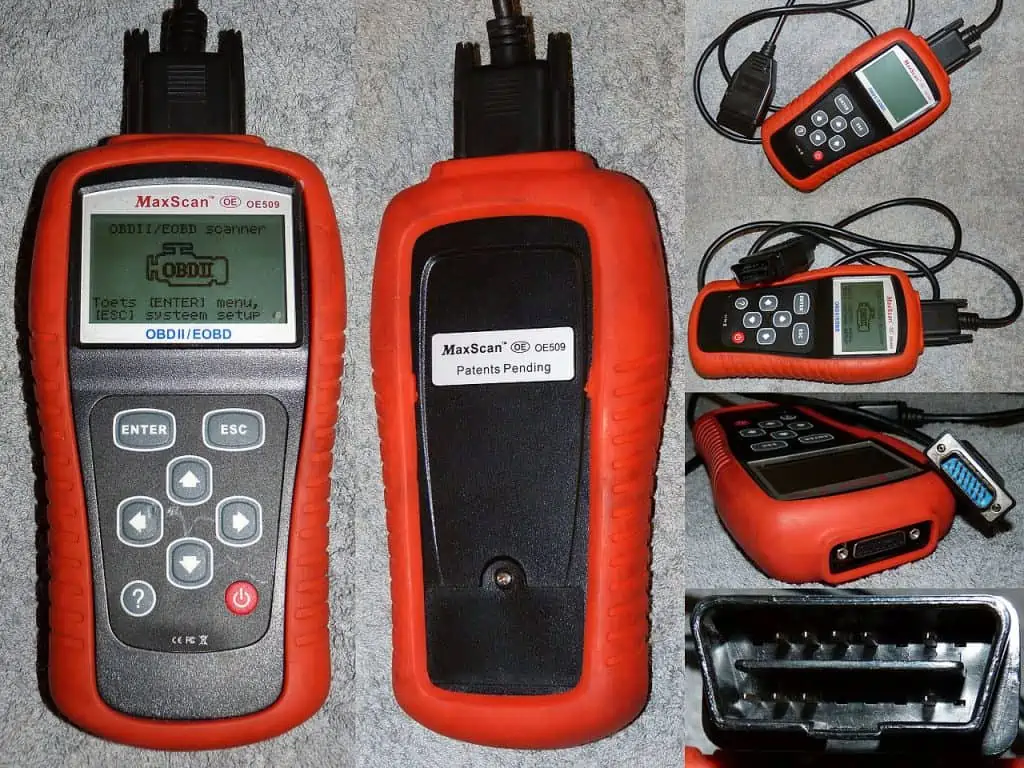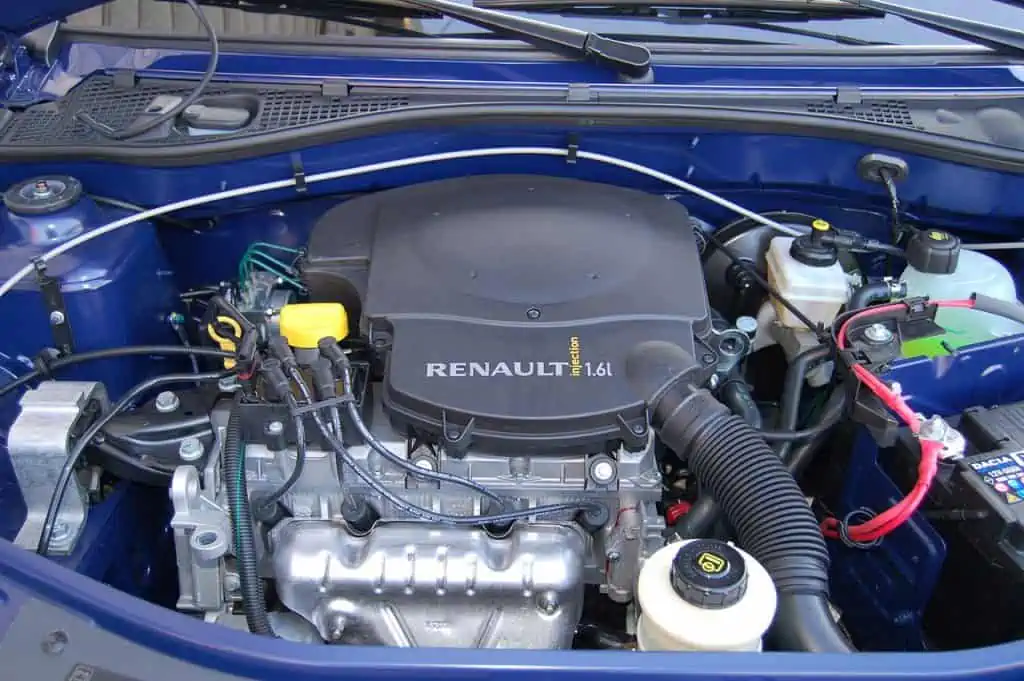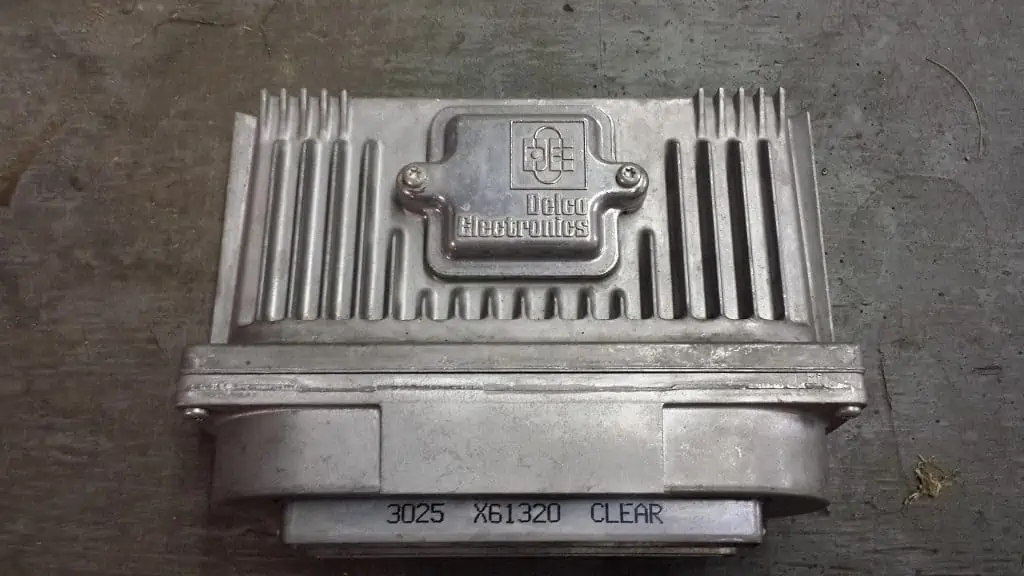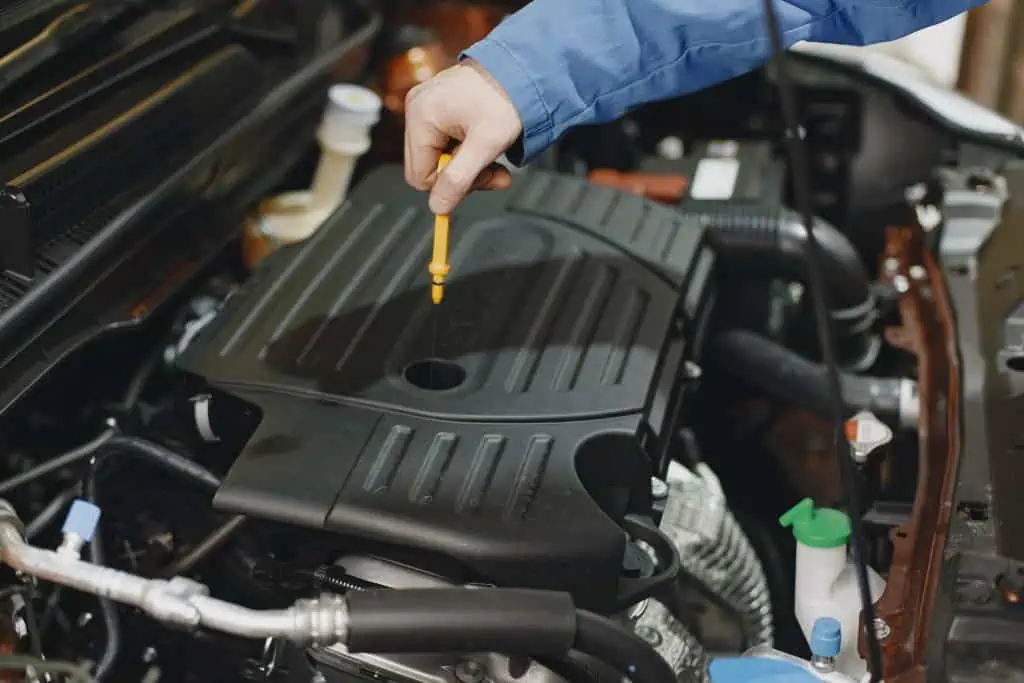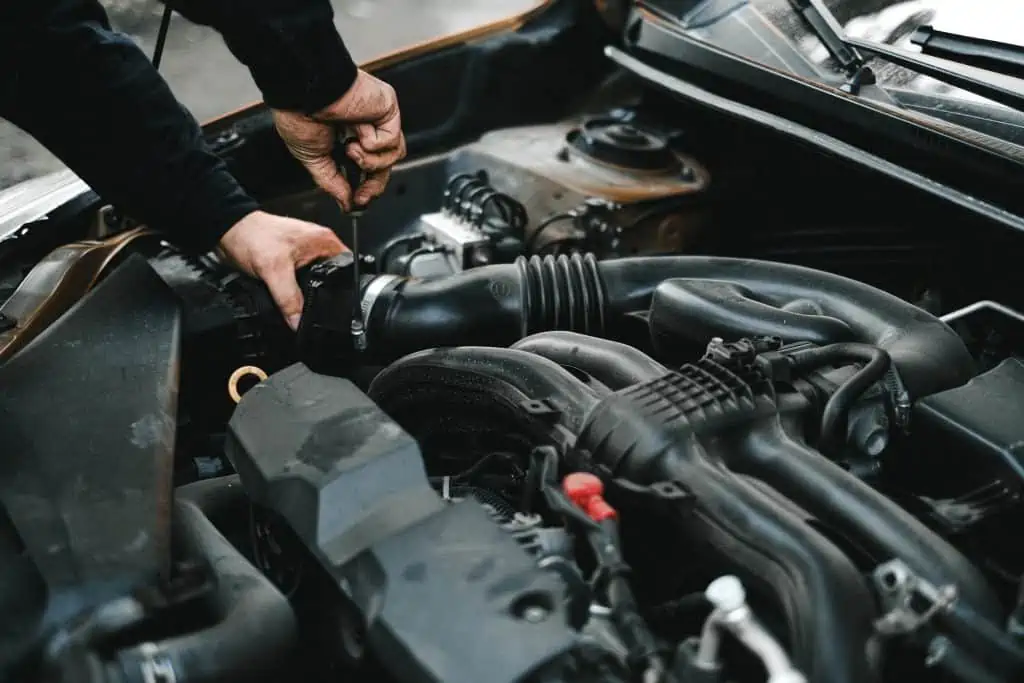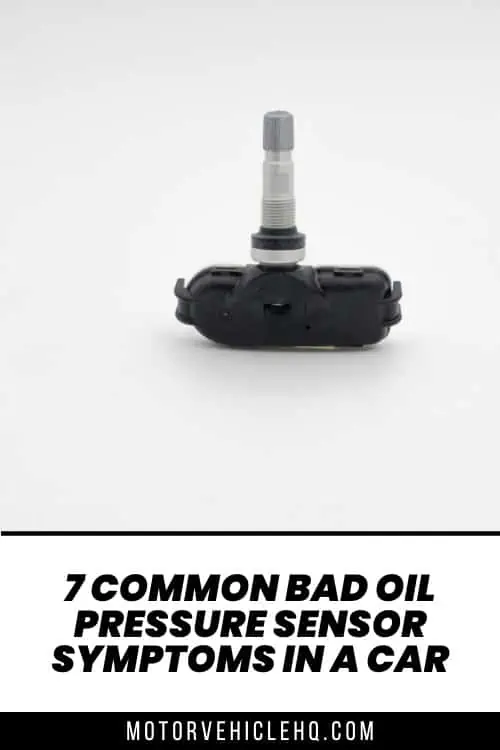To provide your engine with enough lubrication, an oil pump is using high pressure to force oil through the engine of your car. A little instrument known as an “Oil pressure sensor” or “Oil pressure sender” is used to measure this pressure.
For specifics on where it is located in your vehicle, consult your owner’s handbook. It is not always simple to reach, and you might have to remove other components to do so.
You may get a reading of your oil pressure using this little gadget, which is linked to the gauge on the dashboard panel. An oil pressure warning light is also available on the dash panel to let you know when there are issues with the oil pressure (in case you are not paying attention to the gauge).
Your engine’s oil pressure is monitored by the oil pressure sensor, which is why it’s important to keep it working properly. This information can help you identify a faulty oil pressure sensor.
The oil pressure sensor may be a new concept to you. Or, perhaps you do but are unaware of what it is or how it operates.
In this tutorial, we’ll explain what an oil pressure sensor is, as well as some signs that it’s broken and the expense of replacing one if yours is, and we’ll also discuss some symptoms of a defective one.
Your engine’s oil pressure sensor is an essential component. So how can you know if it’s broken and not functioning anymore?
The oil pressure warning light on the car’s dashboard is the most typical sign of a faulty oil pressure sensor. Due to malfunctioning oil control valves, your engine may potentially display the check engine light. A loud engine may result from this.
It’s not necessary to look for all of these; these are just the most typical ones. An expanded list of the signs of a faulty oil pressure sensor is provided below.
An Oil Pressure Sensor: What Is It In a Car?
The name of the device used to detect oil pressure makes it clear that it is an oil pressure sensor. To prevent deterioration of the main engine parts, lubricants are used in all internal combustion engines.
Oil pressure gauges by codybrom / CC BY-SA 3.0. When a car starts making odd noises yet the oil pressure gauge is reading normally, one of the things to check for is a faulty oil pressure sensor. If your engine becomes too hot, the coolant will boil over, which will result in a dangerously high temperature being shown.
During motion, the surfaces of rotating engine components like camshafts and bearings meet. Typically, a clinking sound is heard when two metallic surfaces collide. In addition to generating a lot of heat, these surfaces have significant frictional resistance.
The requirement to reduce friction and stop power loss due to heat generation results from this. In this situation, engine oil is important. Between mating components, it functions as a lubricant and shield.
Specifically, a precise pressure must be used to distribute the engine oil. This particular pressure would guarantee that oil was getting to all areas inside the engine and that no component was running out of oil.
Because of this, it’s important to monitor the oil pressure. An oil pressure indicator light turns on when the oil pressure falls below a specified point. The measurement from the oil pressure sensor, specifically, is what caused it.
Where Is the Oil Pressure Sensor Located In a Car?
Inside the engine oil supply, a duct is a sensor that measures oil pressure. Engine oil is kept in a separate reservoir and then fed to the engine with the aid of an oil pump when needed.
Oil is forced into a designated route by the oil pump. Here, the pressure scale is used to calibrate the resistance provided by the channel to the oil. As a result, the pressure gauge reads something.
What Functions Do Oil Pressure Sensors Serve for a Car?
The pressure transducer that gauges engine oil pressure is an oil pressure sensor, commonly referred to as an oil pressure transmitting unit. The internal resistance of the sensor fluctuates along with variations in engine oil pressure.
In the majority of older cars, the oil pressure gauge and OPS are linked together. Usually, battery power is applied to one side of the gauge, while the ground is supplied on the other by the OPS. The gauge is compelled to move as a result of the OPS altering its internal resistance in reaction to oil pressure.
On many modern vehicles, OPS operation is slightly different. The powertrain control module (PCM), often known as the engine computer, typically takes information from the OPS in a typical system. The instrument cluster in turn activates the oil pressure gauge or warning light as necessary when the module has transmitted the necessary information to it.
The check engine light will be on and a diagnostic fault code will be stored in the PCM’s memory if the PCM notices an issue with the OPS or its circuit.
Some vehicles use an oil pressure switch in place of the oil pressure sensor or in addition to it. When oil pressure falls below a specific level, the switch closes. The low oil pressure indicator light on the dashboard turns on when the switch is closed.
Note: The phrases oil pressure sensor, as well as oil pressure switch, are sometimes used synonymously.
Which Ones are the Typical Bad Oil Pressure Sensor Symptoms In a Car?
For an engine to function properly, the oil pressure must be maintained. Fast-moving metal surfaces generate a lot of heat and friction and need to be constantly lubricated to keep both individual parts as well as the engine as a whole from being harmed.
The oil pressure sensor takes on the responsibility of keeping track of this internal pressure and notifying you right away if there is a problem by sending a signal to the oil pressure gauge on your dashboard. This allows the motorist to stop and inspect the issue before pricey repairs are required.
Check engine light by Wikiuser100000 / CC BY-SA 3.0. Some of the classic signs of a broken oil pressure sensor are check engine lights, flashing or static oil pressure warning lights, erroneous readings on the oil pressure gauge, and rattling noises coming from the engine.
It’s critical to understand the signs of a faulty oil pressure sensor given the critical role they play in maintaining the integrity of your engine. To determine whether there is more than simply a sensor problem, keep in mind that your neighborhood Auto Care offers the instruments necessary to test the engine oil pressure.
1. The Check Engine Light on Your Car’s Dashboard Illuminates
Pay heed to the oil pressure warning light if it appears on your vehicle. Even if your sensor is already damaged and this light comes on, you should still check it out. If the engine sounds quiet and smooth and the dipstick indicates that the oil level is enough, the light is probably only the consequence of a faulty sensor.
Even if the level is good, if the engine is making loud grinding or ticking noises, the oil pump may be broken. In this case, you shouldn’t restart the engine until the problem has been resolved.
If the level is low, this might indicate a loss of pressure caused by a leaking hose or gasket, or it’s possible that the oil is being consumed in the combustion chamber and there isn’t enough oil. If this is the case, you should stop driving until you’ve fixed the problem to avoid severe engine damage that might happen right away.
2. The Oil Light Is Triggered to Illuminate
Your car’s genuine oil pressure issue is probably not intermittent if you’re experiencing it. And it’s quite unlikely that it’s an unstable situation that alternates between states quickly.
So, the most obvious symptom that the sensor itself is failing is presumably an oil light that intermittently blinks. Keep in mind that certain older vehicles may not have a specific low oil pressure light, and in those circumstances, the check engine light may appear.
In any case, have it looked at because not all check engine lights are related to oil pressure. Before proceeding, you should always check to make sure your oil is at the proper amount and that there are no odd noises.
3. Wrong Readings from the Oil Pressure Gauge
A faulty sensor may be the cause of your gauge consistently reading very high or zero. You could obtain a reading of zero because the signal channel has been eliminated, or it can be a sensor internal short that causes a continual high reading.
The issue might be a rusted plug, a damaged wire harness, or a connection that is simply disconnected. It’s crucial to check the dipstick and listen to your engine to make sure there isn’t low oil pressure. Don’t overfill, because doing so might result in a low-pressure scenario that is bad for your car as well as for the oil because of foaming.
4. Engine Making Weird Noises
The engine cycle is produced by the combination of rotating components in the combustion chamber, as was already mentioned above. Surfaces of elements like bearings and camshafts come into contact with one another throughout each turn.
Now, a defective pressure sensor might transmit to the Engine Control Unit (ECU) a signal of high oil pressure while the real oil pressure is low.
In this case, the oil pump will get a command from the Engine Control Unit (ECU) to reduce oil pressure. The oil pressure, therefore, decreases to even lower levels.
This means that certain places won’t get any motor oil. Therefore, in dry conditions, the metallic surfaces will mate with one another. A clinking sound will emanate from the engine.
The clinking noise coming from the engine is a certain sign that the lubricating system in your vehicle is malfunctioning.
Onboard Diagnostics (OBD) handheld scanner by Arp. Cars come with an On-Board Diagnostics (OBD) system to aid in scanning for error or fault codes. A car will communicate an error code to the Powertrain Control Module when it detects an issue so that the engine may be adjusted to fix it. One of the issues it can see is a damaged oil pressure sensor.
5. Leaking Oil from the Oil Pressure Sensor
Your car’s oil system is where the oil pressure sensor is intended to be installed so it can measure the oil pressure. But occasionally, this might result in oil seeping from the threads or through the center of the sensor itself, lowering your oil pressure.
This is a well-known issue with some Vauxhall models, where the oil pressure sensor spills oil through the body’s center, filling the block connector and drenching the engine compartment.
By looking for any oil leaks around the pressure sensor and then removing the sensor’s block connection to check inside for oil, you may quickly identify this problem. If you discover any oil in any of these places, your sensor has to be replaced. While the engine is idling, you can also visually examine the sensor to ensure there is no evidence of oil escaping from the sensor body.
6. Overheating of the Engine
It may provide you with an inaccurate indication regarding the situation beneath your hood if the oil pressure sensor is not functioning properly. Ideally, you’ll hear various sounds emanating from your engine, such as ticking or grinding, BEFORE true overheating occurs.
A malfunctioning oil pressure sensor is one of the things to look for when a car starts producing strange noises while the oil pressure gauge is reading normally. Your engine’s coolant will boil over if it gets too hot, and this will cause an unsafely high temperature to be read (on your dashboard).
A solution must be found as quickly as possible for this terrible predicament!
7. The Oil Pressure Light Continuously Blinks
It typically indicates a major issue when a dashboard warning light is flashing or flickering. Immediately stop driving if you notice the check engine light blinking.
If you continue to drive, your engine might suffer catastrophic damage since there is a serious issue with the engine. A flashing oil warning light, meanwhile, indicates a problem with the engine oiling system in your vehicle.
Checking your car’s engine oil dipstick is the first thing you should do, just like with the other two oil pressure sensor indications. If the oil level is low, top it off with the right quantity of the right kind of motor oil. Following that, if the light is still flashing, you likely have an issue with your oil pressure sensor.
NOTE: While a damaged oil pressure sensor is annoying, it also poses a risk. It rapidly grows tiresome to have to stop every time it appears to confirm that everything is okay. Additionally, you run the risk of becoming complacent and assuming the sensor is defective when a problem has arisen.
A faulty sensor won’t be able to tell you what’s wrong with your engine until it begins generating unpleasant (and frequently expensive) noises. It is worthwhile to replace the sensor immediately away. In the long run, it will spare you the bother and potential harm to your car.
How Can You Troubleshoot the Bad Oil Pressure Sensor Symptoms for a Car?
The symptoms of an oil pressure sensor malfunction are not as specific as those of other defective sensors. It might be difficult to determine what could be wrong, but don’t worry—we’re here to assist. Checking the engine oil level is always the first thing you should do when the oil warning light goes on, as was already said. Here is how to go about it:
1. Evaluating the Oil Level
- Once the engine has cooled, it is necessary to check the oil level. If you have been driving, park it in a flat area and wait for 15 minutes. By letting the oil descend from the engine to the oil sump or pan, you may acquire a precise readout.
Internal combustion engine by Huhu Uet / CC BY-SA 3.0. Your engine may sustain catastrophic damage if you continue to drive while the oil pressure warning light is blinking because the engine is having a major problem. The engine oiling system in your car may be having issues if your oil warning light is blinking.
- Find the engine oil dipstick on your vehicle; it is often located in the engine’s front corner. It often has a yellow handle with the word “Engine” printed on it.
- Take out the dipstick and clean it with a tissue or towel.
- Pull the dipstick out again after fully inserting it again.
- Once more remove it to check the dipstick for engine oil. The dipstick contains a minimum and maximum indication; if it falls below the minimum indicator, you must refill it.
It’s rather easy to refill the engine oil. On the engine’s top is a cap; open it, and add the oil. To prevent oil from leaking everywhere, use a plastic funnel. Start with roughly a quart of oil, check the level with the dipstick, and then add more as needed.
Use the proper viscosity grade of oil for your engine, making sure you use the right type of oil. You should abide by the advice given, which may be found in the owner’s handbook. It is possible to harm an engine by using engine oil with the wrong viscosity grade.
2. Motor Oil Pressure Testing
You may have another issue causing the light to come on if your oil level is okay or you’ve replaced the oil but the caution light is still on.
You have a choice between the two scenarios: the sensor is broken, or your oil pressure is either too high or too low. The oil pressure should be checked first. By logical deduction, the sensor must malfunction if the pressure is normal.
How to check the oil pressure in your engine is as follows:
- Invest in an oil pressure testing kit. On Amazon, there are plenty available for approximately $50 if you need to purchase one.
- On a flat surface, park your vehicle.
- Search for the oil pressure sender on the engine. The oil sump or the oil filter should be around where you’ll find this.
- Remove the switch and place a drip pan beneath.
- To replace the oil pressure sender, locate the adapter in the testing kit that has the same thread as the sender’s and insert it into the corresponding slot.
- Make sure the engine oil level is not low by connecting the gauge to the adaptor.
- Start the engine after that.
- Assist the engine is getting up to operational temperature. Find out what the recommended oil pressure level is for your vehicle by consulting a service handbook in the interim. To get an accurate measurement from some vehicles, you might additionally need to crank the engine to a specific RPM.
- As you read the gauge, if required, ask a friend to assist you in revving the engine to the desired RPM.
- Check the oil pressure gauge to verify whether it is within the range recommended by the manufacturer.
You must fix the problem if the oil pressure is too high or too low. However, if the oil pressure is normal, your oil pressure sensor is broken if it is normal.
Engine Control Unit by User:Mgiardina09 / CC BY-SA 3.0. The Engine Control Unit (ECU) may get a signal of excessive oil pressure from a faulty pressure sensor even when the actual oil pressure is low. In this scenario, the Engine Control Unit (ECU) will issue a directive to the oil pump to lower oil pressure. As a result, the oil pressure drops even further.
3. How to Use an OBD Scanner to Verify Oil Pressure Sensor Symptoms
Since we now know that your oil pressure is normal and the only other potential reason is a broken oil pressure sensor, the following step is not required. On-Board Diagnostics (OBD) scans may be performed on your vehicle if you wish to double-check.
The system’s issue codes may then be located in this manner, and those connected to the oil pressure sensor can be found and fixed.
Cars include an On-Board Diagnostics (OBD) system to help scan for error or fault codes, in case you weren’t aware. When a car notices a problem, it will send an error code to the Powertrain Control Module so that the engine may be modified to correct the problem.
If it is unable to resolve the issue, the error code will be recorded on the OBD and the warning light will turn on.
Remember that this technique will only work on vehicles with an OBD-2 system that was manufactured after 1996. Because OBD-1 systems are proprietary, you’ll need to check the instructions for your specific car’s make and model. In light of the foregoing, this is how to scan an OBD-2 system:
- Get an OBD-2 reader/scanner. As long as a car has an OBD-2 system, they are universal and will function in any vehicle.
- Install the reader in the vehicle’s OBD port. If you want to know where it is in your vehicle, check your owner’s handbook or the internet.
- Start the OBD scanner after it has been connected. The vehicle should be scanned right away. You might need to enter other data, such as the make, model year, VIN, etc., for some scanners.
- Following that, it will display the fault codes it has discovered and record them.
The OBD Trouble Codes to Watch Out for When Troubleshooting Bad Oil Pressure Sensor Symptoms In a Car
A vehicle may display one of the more than 5,000 problem codes. However, keep an eye out for these engine oil-related fault codes:
- Engine Oil Pressure Sensor/Switch Circuit Malfunction is indicated by code P0520.
- Engine oil pressure sensor/switch range/performance is denoted by code P0521.
- Engine oil pressure sensor/switch low voltage is indicated by the code P0522.
- Engine Oil Pressure Sensor/Switch High Voltage is represented by code P0523.
The cause of the P0520 and P0521 codes is probably a sensor issue; frequently, shorted wire inside the sensor is to blame. A short in the wiring can result in erroneous voltages, which causes the sensor to get an inaccurate measurement and believe that the vehicle’s oil pressure is low.
Along with a broken pressure sensor, other mechanical and fluid-related issues might cause the low oil warning lights to come on. Your engine may have low oil pressure due to its low oil level. A faulty pump may also be the blame.
The P0522 error code, on the other hand, indicates that the sensor is reporting the oil pressure as being below the acceptable range. Additionally, the P0523 error number indicates that the sensor is reading a value that is too high.
This often indicates that your oil pressure is either too low or too high compared to the recommended range. However, given that we have already verified that the oil pressure is normal, this suggests that the oil sensor is broken.
What Does It Cost to Replace a Faulty Oil Pressure Sensor?
Depending on the year, make, and model of your vehicle, the cost to repair an oil pressure sensor will range from $100 to $210. Fortunately, the cost of the new oil pressure sensor is not excessive. An oil pressure sensor is inexpensive and may be purchased for $50 to $120 at any auto store.
It’s also not a difficult process to replace an oil pressure sensor. Accordingly, labor costs range from $50 to $90 when replacing an oil pressure sensor. This would result in an overall cost of $100 to $210 for replacing the oil pressure.
Service shops frequently charge somewhat more if you drive a premium vehicle.
Identifying a Malfunctioning Oil Pressure Sensor
If you know the sensor’s accurate data, identifying a defective oil pressure sensor is frequently rather simple. Sometimes, a sensor will only have one or two pins, and these pins must have a certain resistance to the ground.
You should consult your service handbook or the owner’s manual for the oil pressure sensor if you want to know the precise resistance at a certain oil pressure.
Is It Possible to Replace a Bad Oil Pressure Sensor On My Own?
You can, indeed. It’s a rather easy task to do. This is how:
Using a car jack, raise the front of your vehicle, and then position it on a jack stand. Use wheel chocks if you have any for extra safety and be sure to apply the parking/emergency brake in advance.
Find the switch for the oil pressure sensor. It often sits close to the oil sump.
The wire harness should be taken out and cleaned if necessary.
You may buy oil pressure switch sockets in addition to utilizing a socket to remove the oil pressure sensor switch. You’ll need to determine that because each car’s dimensions can be different. Put a drain pan below it as well since oil will leak from it.
The threads of the new oil pressure sensor should be sealed. Consult the manufacturer’s instructions before proceeding with some sensors since they might not require you to do this.
Using a socket, tighten the new sensor firmly after manually threading it into the slot.
Reconnect the electrical harness to the new oil pressure sensor. Whenever required, keep in mind to clean it beforehand.
If there is still an oil pressure warning light, start the engine and check.
It’s possible that a little amount of oil was lost from your engine throughout the operation. Examine the engine oil dipstick and top off the oil as necessary.
You did an amazing job; give yourself a congratulatory pat on the back.
It doesn’t cost too much to replace an oil pressure sensor in terms of labor. You’ll save at least $70 if you do it yourself though. Moreover, if done correctly, it won’t take more than an hour and won’t be a tough task or anything that may go disastrously wrong.
You should change your oil together with your oil filter every time. If you change the oil at 10,000 miles but not at 15,000 miles, for example, you don’t need to change the filter again. Contaminated oil and dirty air filters are also reasons for oil pressure sensor failure.
Is It Safe to Drive While the Oil Pressure Sensor Is Faulty?
A low oil pressure warning on the dashboard is never anything you should put the fault of the OPS. One potential cause of the problem is a real drop in engine oil pressure.
So, once the low oil pressure warning light illuminates on the dash, you should immediately turn off the vehicle to reduce the possibility of costly internal engine damage. Have the car hauled to the preferred location for a diagnosis after that.
If you discover that the car’s OPS is broken (or your mechanic does), you need to fix it straight soon. Without a working OPS, you won’t be able to see if the engine oil pressure becomes dangerously low.
The Oil Pressure Sensors: How Long Can They Last In a Car?
On the majority of vehicle models, oil pressure sensors are built to endure a very long time—typically the lifespan of the vehicle. Wearing them out is also quite uncommon. In contrast, they are susceptible to failure over time just like any other part of your vehicle.
What Is the Turnaround Time for an Oil Pressure Sensor Replacement?
Although the length of time required may vary depending on the make and model of your car, replacing an oil pressure sensor shouldn’t take more than an hour. To make sure the process is done properly, it is usually preferable to get the advice of a qualified technician if you are unfamiliar with working on vehicles since it may take longer.
How Is the Oil Pressure Sensor Reset?
Normal oil pressure sensors can’t be reset. If everything is in order and there are no more problems with the wiring or oil pressure after you install the new one, you should simply start the vehicle engine and the oil pressure light should go off.
What Should I Do In the Event of High Oil Pressure?
Usually, when there is a blockage someplace, high oil pressure results. Oil flow will become much more difficult when something is obstructing it since there will be resistance, which will lead to high pressure. An unclean oil filter is the first of four potential offenders.
Every time you replace your oil filter, you should also change your oil. You don’t need to change the filter again if you change the oil at 10,000 miles, for instance, and you didn’t change the oil at 15,000 miles.
At the 20,000-mile oil change, you must, however, replace it. You could be using the improper viscosity grade, which brings us to our second concern. The high oil pressure will come from the oil’s excessive thickness since it will encounter greater resistance when moving through the narrow passages.
The oil pressure relief valve has to be examined next. When the system’s pressure becomes too high, these valves automatically open to release the added pressure. If this valve has a problem, it won’t be able to work properly, and you’ll need to replace it.
The pathways through which the oil travels can also be blocked. It can be because the route is now filled with sludge. After all, you were past due for an oil change. Whatever the source, this one might be difficult to diagnose and cure, therefore we advise having your trusted technician do the repair work.
Some of the classic signs of a broken oil pressure sensor are check engine lights, flashing or static oil pressure warning lights, erroneous readings on the oil pressure gauge, and rattling noises coming from the engine.
What Should I Do In the Event of Low Oil Pressure?
Apart from low oil levels, which we have already highlighted several times in this text, there are three more potential reasons for low oil pressure. To start, you could be using the incorrect oil viscosity. It will encounter less resistance if the oil is too thin compared to what you should be using, which might result in low oil pressure.
Bad oil pumps are the second potential explanation. The oil pump, as the name suggests, moves the oil from the sump into the engine. The oil pump won’t be able to pump oil as forcefully as it should if it is worn out or failing. Low oil pressure is the natural outcome of this.
And finally, if you drive an older vehicle, your engine likely has severe wear. The initial flow restriction of the engine can be reduced by excessive engine wear, allowing oil to flow more freely but resulting in low oil pressure. You’ll probably require an engine rebuild in this situation, which might cost thousands of dollars.
The Conclusion
A very crucial sensor for your vehicle is the oil pressure sensor. It is so crucial that your dashboard has a separate light only for it.
Check engine lights, blinking or static oil pressure warning lights, inaccurate readings on the oil pressure gauge and rattling noises from the engine are some of the typical indications of a damaged oil pressure sensor.
It is not a difficult procedure to replace the oil sensor. But you must be certain that the underlying issue is associated with it. A faulty oil pressure sensor occasionally exhibits ill-defined symptoms.
The low oil warning lights may illuminate for a variety of mechanical and fluid-related reasons in addition to a faulty pressure sensor. The low oil level in your engine may be the cause of low engine oil pressure. Also, a defective pump can be to blame.
Because of their straightforward construction, oil sensors are frequently inexpensive to purchase and simple to repair.
Just be careful when replacing the sensor and keep an eye out for any oil leaks when you take the sensor out of the engine block. Additionally, you’ll want to be cautious to avoid over-tightening your new sensor because this is simple to do.
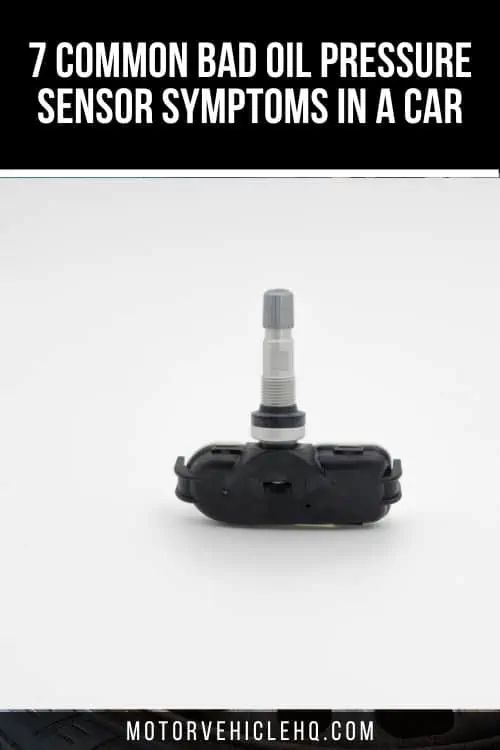

Nyangano Maurice specializes in vehicle troubleshooting and has more than 10 years of experience in the automobile industry. Over many years of experience as a car mechanic, he has acquired a broad range of skills, including engine repair, brake systems, electrical systems, and more. He frequently hosts community workshops and training programs to help motor vehicle owners understand their vehicles better.
